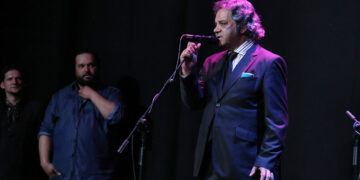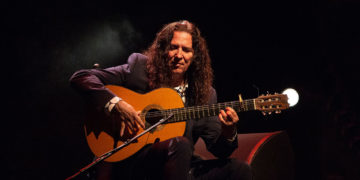
FESTIVAL DE FLAMENCO DE NIMES De Tangos y Jaleos, Raza flamenca Extremadura
|
|
Text: Estela Zatania Artistic director: Miguel Vargas. Cante: La Kaíta, Alejandro Vega, Domingo “El Madalena”. Dance: Antonio Silva “El Peregrino”. Guitar: Miguel Vargas, Juan Vargas, Nene Salazar. Percussion Francisco Suárez “Kiko” Throughout the week at the Nimes festival there have been various conferences with speakers such as José de la Vega, Claude Worms, Corinne Savy and José Manuel Gamboa among others. Yesterday’s topic, laid out by Francisco Zambrano and titled “Extremadura in Flamenco: cantes and interpreters”, was the perfect prologue for what would take place in the theater that evening. There was a sense of excitement surrounding the “exotic” show from Spain’s far west that would take over the stage at the Theater of Nimes. On this occasion there would be nothing “experimental” or “ground-breaking”. Two men singers, one woman, three guitars, a cajón and a surprising seventy-something dancer would get the sophisticated French audience rocking. A triumphal night at Seville’s last Bienal de Flamenco led to this show’s inclusion in the Nimes festival thanks to the organization’s intelligent criteria. The flamenco artists of Extremadura make up for their inferiority complex about not being from Andalusia by passionately defending their own cultural heritage, which preserves the characteristic flavor of their music. Here in France there was no need to promote local identities since flamenco is seen as a single homogenous artistic genre, but the strong flavor of the tangos and jaleos was a wonderful discovery for many people. Laidback melodies that linger from chord to chord, choruses sung by the whole group, a rhythm that neither rushes nor pauses and the aroma of simpler times. Extremaduran flamenco is a journey to past times that continue to thrive in the present and which won’t lose relevance because the product is not perishable. You listen to the characteristic melodies of these tangos and jaleos, or what years ago we called “bulería extremeña”, and everthing is flavor, the complete absence of fashions and outside influences. In the darkness of the theater a thought comes to me: flavor is the antithesis of fusion. The audience was completely enthralled…one man behind me whispered to his partner “that’s from Camarón”. But in actual fact, these cantes had been circulating in Extremadura for a very long time thanks to the recordings of Porrinas de Badajoz, and it was Camarón who later came along and popularized them. Fifty years ago, to say “tangos” was to say “tangos de Cádiz”. Nowadays, all flamenco singers include Extremeduran cante in their repertoires. The easy swing of jaleos in musical phrases of three recalls the compás of Lebrija, although the mixed compás (amalgam) of bulerías is always just below the surface or is even expressed now and again. Singer Madalena did the famous fandangos of Pérez de Guzmán with its characteristic abandolao rhythm. La Kaíta, the only woman in the group, has a voice of tightly wound copper which breaks into a bone-chilling primal scream, an over-the-top delivery you grudgingly accept only because you feel the singer’s compelling need to express herself in this way. She did fandangos accompanied “por medio” which gave a retro flavor. Miguel Vargas, the leader of the group, dedicated a piece to all the Spanish immigrants in France, and La Kaíta offered her jaleos to Diego Carrasco and Bobote with verses that spoke of Extremadura and its flamenco songs. One member of the group set the audience on fire each time he came on. In 1963 El Peregrino won first prize for dance in an important contest in Jerez. He is a rigorously elegant dancer with a deeply expressive face who knows how to administer his strength and is energetic and spontaneous. In the end, his dancing triggered the first rhythmic applause of the week. There was an encore in which La Kaíta sang for his bulerías, and the audience would simply not let the people from Extremadura off the stage. Another encore, this time tangos, Peregrino sang, then he danced with Kaíta, the house went wild and everyone stood and cheered. A third encore…or was it the fourth, can’t remember….was an instrumental rumba with tropical flavor. All in all, it was an unforgettable evening. One hour later in the Odeón café cantante, local dancer Eva Luisa offered her show “Acuérdate” with the guitar accompaniment of Antonio Moya. Flamenco Festival Nîmes 2012 – All the information
|
Descubre más desde Revista DeFlamenco.com
Suscríbete y recibe las últimas entradas en tu correo electrónico.

























